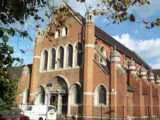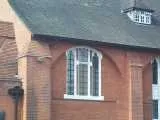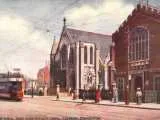Churches and places of worship
The churches and church halls add variety and interest to the suburban townscape, standing out in a sea of terraced housing and uninspiring modern estates .
All Saints Church does tend to be regarded as the jewel in the crown of the local heritage. There are also quite a few pictures and paintings of it around and this helped to add colour to the site before I started taking lots of photos. The other local churches and places of worship also tend to be a little different to the surrounding buildings so I feel are worth highlighting. The map above locates those church buildings that are still standing, even if no longer actively used for places of worship.
My interest is in the buildings, but I've linked to the church websites where I am aware of them.
Active places of worship
To the best of my knowledge, all the following buildings are actively used as places of worship. It has not been my intention to overlook any so if you think I have please let me know. Remember, however, that it is church buildings I am looking at so if a church meets in a terraced house or something I wont have considered it.All Saints with St Michael (Church Of England)
Website: >



All Saints Church, which lies on the south side of Church Street a little to the west of Victoria Road, is the ancient parish church of Edmonton. Domesday makes no mention of a priest in Edmonton but that doesn't necessarily mean there wasn't a church and All Saints has been found to have fragments of Norman work. I have seen these dated as c. 1100 but have also seen 1163 as a firm date of the first church on the site.
The church is most often described as predominantly 15th Century (Dalling calls it 14th Century in one of his books but that might be a typo) and it is built of Kentish ragstone. In the 18th Century (1772 is one year that is quoted) there was some refurbishment with the north side ending up refaced in brick. Eccleston goes further and says the whole north aisle is 18th Century. I will just note that the windows on the north side clearly match those on the west side but they could of course have been moved.
There were restorations of the church in 1855 and 1871 by Ewan Christian, who apart from his work as an ecclesiastical architect also designed the National Portrait Gallery. There was then a major restoration and extension in 1889 by W. Gilbee Scott which included the addition of the south aisle.







There are several sketches and paintings of the church to be found on the Collage web site which may be of interest. They date from 1790 to 1825.
All Saints was the only church in the Parish Of Edmonton until 1615 when a chapel was built in Southgate but there wasn't much activity after that until the mid- to late-19th Century when a couple of churches were built in Upper Edmonton and then at the beginning of the 20th Century a few were built in Lower Edmonton. The closure of St Michael's brought the parish back in with All Saints so the church is now named All Saints With St Michael.
St Alphege's (Church Of England)



St Alpheges lies on the Hertford Road just south of the junction with Galliard Road and with an entrance on Rossdale Drive. It was built in 1958 and designed by Edward Maufe who is particularly noted for having designed Guildford Cathedral. It has had a more recent addition (1990s? 1980s?) in the form of the over large and intrusive side extension visible in the centre picture above. I am sure this was needed and is functional but it takes up most of the churchyard.
It made it to the 'Edmonton Heritage Trai' alongside much older buildings but whether this is simply because of the association with the architect or because they consider it has special merit regardless, I couldn't say.
St Alphege's was previously located just south of Tramway Avenue and it was a 'tin church' that would have opened in 1897. Apparently tin churches or 'tin tabernacles' were built from the 1870s onwards in areas where was only a small congregation to cater for and this area of Edmonton would have been pretty lightly developed back then.


The war memorial just about visible in the second picture (apologies for the poor quality) was relocated with the church. Am I imaging things or wasn't there also a horse trough or something out the front to the left of the gate at some stage?
At first glance the church seems in very good condition but a close up of the window on the east side demonstrates that there has been some weathering and/or atmospheric damage to hte figure of Christ Crucified.
St Peter's (Church Of England)


St Peter's on the junction of Bounces Road and St Peter's Road was built in the late 19th Century to designs by Newman and Newman (1896 is one date quoted) and has a hall alongside (photo right). Originally part of the All Saints parish it was later amalgamated with St Martin's which is now used by the Greek Orthodox community.
St Demetrios (Greek Orthodox)


St Martin's on Town Road (between Logan Road and Ranworth Road) was designed by E.L. Warne with dates of 1909 or 1912 being quoted. The parish was merged with St Peter's and now the church is used by the Greek Orthodox Community and is under the patronage of St Demetrios.
St Edmund's (Roman Catholic)



St Edmund's on the junction of the Hertford Road and Croyland Road was the first Catholic church in Edmonton and was erected between 1905 and 1907.



The church has other buildings in the same style grafted on to the west side and also has a substantial hall running alongside Millbrook Road.
Edmonton Baptist Church



Edmonton Baptist Church used to be on The Broadway. After all the redevelopment an interesting new building was erected between Monmouth Road and the shopping centre in 1976. It seems to have grown over the years to reach Monmouth Road itself now. They seemed quite keen on the slogan 'The Church On The Green' at one stage.

I was sent a couple of photos taken from the top of the tower blocks that showed demolition and construction underway simultaneously around The Broadway and New Road area and I've been able to crop the photo to highlight the previous Baptist Church.
Edmonton Methodist Church



Edmonton Methodist Church is on the north side of the Fore Street junction with Brettenham Road. The existing building dates from 1929 and was formerly the Sunday School and meeting rooms associated with the huge Central Hall which opened in 1911 and stood next door. Brettenham Road was realigned in the 1970s so the Central Hall could well have stood until then (I can't remember it myself).
The photo of Central Hall shown is from a postcard used in 1913 and I notice that on the left of it there seems to be a more traditional looking church which is rather where I'd assume the present building stands. Certainly a chapel stood on this site, or very close by, in the 19th Century.
Salvation Army


I always I always thought the Salvation Army citadel on Fore Street, next to the old Library, had a sort of Pippin Fort look to it and it was certainly a landmark and an interesting building. To the disappointment of many locals it was demolished many years back. The Salvation Army pointed out that it was only the street front that was at all interesting and the rest of the building was actually pretty tatty but I still think it would have been nice if they could have done something to maintain the old facade.
The new building does at least still stand out from its surroundings a bit but largely from being set back from the street a little. For me it would have been improved by having some windows or something in the street facing wall to give it some character. I notice it says 'Worship and Community Centre' which sounds a little wishy washy compared to 'Citadel'.
Faith House (United Reform Church)


'Faith House Christian Revival Centre' is what it says on it and it is used by the United Reform Church. It is a single story building with a green pointy thing on the roof (did I tell you I don't know much about architecture?) on the west side of Fore Street south of Shrubbery Road between The Steps pub (as was) and the entrance to Community House.
Bury Street Chapel (Evangelical)

Bury Street Chapel is on the north side of Bury Street West to the west of the junction with Wellington Road. Apparently it originated in meetings over a shop in 'Bury Street Parade' (?) in 1938. The Brethren planned a hall in Bury Street in 1939 and a temporary hut was erected after the Second World War, followed in 1951 by a permanent brick chapel which is presumably the building we see today.
I.C.C. House Of Prayer (International Charismatic Chapel)


The building on the corner of the Hertford Road and Bury Street was once, and perhaps still is, known as Maton Hall. In 2002 it was being used by the I.C.C. House Of Prayer, a charismatic church.
The building may well be the original St Michael's Mission Hall from 1988 and was, I believe, used as the church hall before being sold off and passing into the hands of the Co-Op.
Tramway Christian Fellowship (Elim Pentecostal)

This is on Tramway Avenue just up from the Hertford Road. I believe it may have been the church hall for St Alphege's at one time.
The list of Elim churches also mentions the Path Of Life based at Edmonton Leisure Centre.
New River Church (Evangelical)

The New River church, formerly the Croyland Evangelical Church, is on the east side of Croyland Road north of Junction Road.
Redundant Churches
Some church buildings (well actually only one I can think of) are no longer used for places of worship but remain intact.St Michael's (Church of England)




St Michael's is on the north side of Bury Street near to the junction with the Hertford Road. It was constructed in 1901 to the designs of W.D. Caröe and made redundant in 1982. It has been converted into flats. The church is listed Grade C (Group Value) and the vicarage Grade II (Group Value).

I have seen the church referred to as St Michael Bassishaw rather than simply St Michael's. I believe its building was funded in part or whole by proceeds resulting from the demolition of another St Michael Bassishaw which I believe was in the CIty. I'll have to look that one up again though.
Demolished Churches
Earlier on the page there is mention of church buildings that have been demolished and replaced by new ones. However there are some that were demolished and not replaced.St Mary's (Church of England)

St Mary's was on the east side of Fore Street just over in Upper Edmonton south of the old junction with Brettenham Road (which was more or less opposite Park Road). Designed by WIlliam Butterfield, it was consecrated in 1884 and demolished in 1957.
Congregational Church

Knight's Lane car park just south of The Green (now obliterated by the Asda car park) was once the site of the Lower Edmonton Congregational Church (commonly called 'the Independent Church') which opened in 1883. It was suggested by Gary Boudier on the message board that it was demolished c. 1957 and Graham Dalling at the Local History Unit supports this date. The Lower Edmonton Congregationalists merged with the Edmonton and Tottenham ones and opened a new church some time in 1959 or a little after according to the Victoria County History (this must be Faith House mentioned earlier).